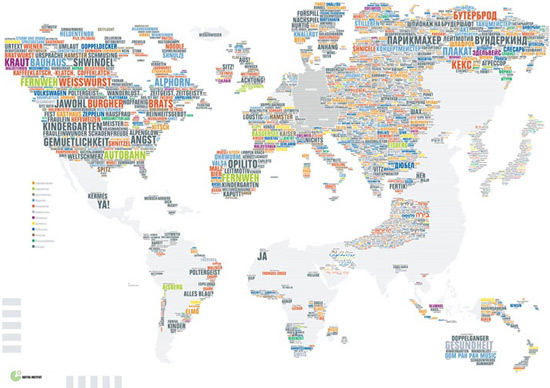Reblogs for 20100918
Reblogs for 20100915
- Kumi Yamashita
A few folds made in origami paper by Kumi Yamashita together with the right light and profiles appear.

found at Potz!Blitz!Szpilman!
- Emotiv EPOC EEG Headset Hacked
Cody Brocious has created Cody’s Emokit project, an open-source library for reading data directly from the Emotiv EPOC EEG headset, a consumer brain-computer interface (BCI) using signals from the brain and facial muscles.
“We’ve never had access to this equipment at the consumer price-point before, and now with Emokit and OpenViBE, there are a lot of possibilities for apps, from controlling your music with an Apple iPod in your pocket, or even robotics research.”
Reblogs for 20100911
- DeVinne Ornamental

DeVinne Ornamental
- Researchers Give Robots the Capability for Deceptive Behavior

Georgia Tech Regents professor Ronald Arkin (left) and research engineer Alan Wagner look on as the black robot deceives the red robot into thinking it is hiding down the left corridor. (Click image for high-resolution version. Credit: Gary Meek)
A robot deceives an enemy soldier by creating a false trail and hiding so that it will not be caught. While this sounds like a scene from one of the Terminator movies, it’s actually the scenario of an experiment conducted by researchers at the Georgia Institute of Technology as part of what is believed to be the first detailed examination of robot deception.
We have developed algorithms that allow a robot to determine whether it should deceive a human or other intelligent machine and we have designed techniques that help the robot select the best deceptive strategy to reduce its chance of being discovered,” said Ronald Arkin, a Regents professor in the Georgia Tech School of Interactive Computing.
The results of robot experiments and theoretical and cognitive deception modeling were published online on September 3 in the International Journal of Social Robotics. Because the researchers explored the phenomenon of robot deception from a general perspective, the study’s results apply to robot-robot and human-robot interactions. This research was funded by the Office of Naval Research.
In the future, robots capable of deception may be valuable for several different areas, including military and search and rescue operations. A search and rescue robot may need to deceive in order to calm or receive cooperation from a panicking victim. Robots on the battlefield with the power of deception will be able to successfully hide and mislead the enemy to keep themselves and valuable information safe.
“Most social robots will probably rarely use deception, but it’s still an important tool in the robot’s interactive arsenal because robots that recognize the need for deception have advantages in terms of outcome compared to robots that do not recognize the need for deception,” said the study’s co-author, Alan Wagner, a research engineer at the Georgia Tech Research Institute.
For this study, the researchers focused on the actions, beliefs and communications of a robot attempting to hide from another robot to develop programs that successfully produced deceptive behavior. Their first step was to teach the deceiving robot how to recognize a situation that warranted the use of deception. Wagner and Arkin used interdependence theory and game theory to develop algorithms that tested the value of deception in a specific situation. A situation had to satisfy two key conditions to warrant deception — there must be conflict between the deceiving robot and the seeker, and the deceiver must benefit from the deception.
Once a situation was deemed to warrant deception, the robot carried out a deceptive act by providing a false communication to benefit itself. The technique developed by the Georgia Tech researchers based a robot’s deceptive action selection on its understanding of the individual robot it was attempting to deceive.
To test their algorithms, the researchers ran 20 hide-and-seek experiments with two autonomous robots. Colored markers were lined up along three potential pathways to locations where the robot could hide. The hider robot randomly selected a hiding location from the three location choices and moved toward that location, knocking down colored markers along the way. Once it reached a point past the markers, the robot changed course and hid in one of the other two locations. The presence or absence of standing markers indicated the hider’s location to the seeker robot.
“The hider’s set of false communications was defined by selecting a pattern of knocked over markers that indicated a false hiding position in an attempt to say, for example, that it was going to the right and then actually go to the left,” explained Wagner.
The hider robots were able to deceive the seeker robots in 75 percent of the trials, with the failed experiments resulting from the hiding robot’s inability to knock over the correct markers to produce the desired deceptive communication.
While there may be advantages to creating robots with the capacity for deception, there are also ethical implications that need to be considered to ensure that these creations are consistent with the overall expectations and well-being of society, according to the researchers.
“We have been concerned from the very beginning with the ethical implications related to the creation of robots capable of deception and we understand that there are beneficial and deleterious aspects,” explained Arkin. “We strongly encourage discussion about the appropriateness of deceptive robots to determine what, if any, regulations or guidelines should constrain the development of these systems.”
- FOUR GREAT INFOGRAPHICS No. 9

Dataflow 2 is a collection of the latest data visualizations and information graphics sprouting from the fledgling infoviz scene. Everything’s here: computational art, newspaper infographics, academic spidergrams. Although there is a strange absence of work from Information Is Beautiful. Grump!Nevertheless, it’s a generous pie-slice of interesting and intriguing and WTF? work from international designers big and small. All large-printed on lovely shiny paper. Worth a look.
You can order it on Amazon US and UK. DataFlow 1 is also a seminal collection (US | UK).
Highlights
Here are a few of my favourites from the book.
(Disclosure: The publisher Gestalten sent me a free review copy.)
Rosemarie Fiore
This New York based artists took long exposure shots of classic video games, revealing the hidden logos of the game, normally unseen by the eye. See if you can guess the game…
N.B. Her visualisation of the hidden paths of amusement park rides are also pretty wow too.
Zero By Zero
Amazing Japanese studio specializing in modern re-mixes of railway maps. Better looking, cooler curves, characterful detail. Here’s Tokyo
They’ve recently just re-envisioned the London Underground map too.
(Their site is chunking a bit. But you can check out their Flickr)
Golden Section Graphics
I really like the work of this German infographic design outfit, especially when they pare it all down to the essentials. This graphic of exported German words used around the world exemplifies their awesome-ness.Other work for German newspaper Die Zeit ist wunderbar also.
Life Map
This is old but gold. Information designer Ritwik Dey decided to make his life look beautiful and visualised his CV. Four years later it’s still a stunning piece of info design.If you’re intrigued by DataFlow 2 you can order it on Amazon US and UK. DataFlow 1 is also a seminal collection (US | UK).
Thanks to Joe Swainson for research and picture editing
Reblogs for 20100910
- Photo

- 30% of surveyed PS3 owners own more than 20 games, and other fun facts

Did you know that Kratos is the most popular PlayStation character (with Nathan Drake a close second)? And did you know that 40% of PS3 gamers can’t be in a relationship with someone that “gets in the way of their gaming”? Sony shared some fun facts for its 15th anniversary.
 30% of surveyed PS3 owners own more than 20 games, and other fun facts originally appeared on Joystiq on Thu, 09 Sep 2010 11:40:00 EST. Please see our terms for use of feeds.
30% of surveyed PS3 owners own more than 20 games, and other fun facts originally appeared on Joystiq on Thu, 09 Sep 2010 11:40:00 EST. Please see our terms for use of feeds. - Big Air
Reblogs for 20100908
- Ugh, don’t make me Bumblebee your ass.

Ugh, don’t make me Bumblebee your ass.
Reblogs for 20100907
- Photo

- Photo

- ALERT: Massive New Survey Worm Spreading On Facebook
 A group of developers have found a loophole in Facebook’s application Platform which enables them to automatically post messages to a user’s wall. This loophole doesn’t require any action by the user, it simply posts to the user’s wall the moment they load the application. Right now the messages being spread state “I thought this survey stuff was GARBAGE but i just went on a shopping spree at walmart thanks to FB”. This is a scam, do not click on any of the applications!
A group of developers have found a loophole in Facebook’s application Platform which enables them to automatically post messages to a user’s wall. This loophole doesn’t require any action by the user, it simply posts to the user’s wall the moment they load the application. Right now the messages being spread state “I thought this survey stuff was GARBAGE but i just went on a shopping spree at walmart thanks to FB”. This is a scam, do not click on any of the applications!
This happens to be one of the fastest spreading scams we’ve seen on Facebook to date, and also one of the largest security glitches in the Facebook Platform. While we’re not aware of any viruses that result from the system, it appears to be the standard offers system which is driving this scam. In other words, once users enter their email, they are prompted to complete an offer. There’s also a risk of having your phone number charged by entering it on the form, however we haven’t confirmed that yet.The clear message is this: do not click on any of the links if your friends post it. It will immediately post to your wall. This is fairly widespread as there are numerous applications that are spreading the scam. There appears to be thousands of applications that have been used as part of this scam, which will make it much more time consuming for Facebook to shut down the scammers.
We will update this post as we get more information. Right now there are countless applications that are being used. It would take us too long to list every application, however you can see all the people being impacted here. As we mentioned before: do not click any of the links in these messages. Also, be sure to share this with your friends so they don’t fall for the scam as well!
Update
The spammers have also figured out a way to automatically message your friends (as seen in the image below).
- ALERT: Facicons Is Spreading Facebook Emoticon Spam
 Want to add emoticons to your Facebook status update? There are a million applications to accomplish this (see our list of Facebook emoticons apps), however Facicons now appears to be spreading spam on Facebook rather than friendly smiles. When you update your status with Facicons, there’s a message which states “I’ve added smileys to this status update. Wanna see them? Go to http://s.facicons.com/”. It then prompts you to install the application, thus continuing the cycle of emoticon spam. While we previously thought this application was friendly, it only appears to be good at spreading spam.
Want to add emoticons to your Facebook status update? There are a million applications to accomplish this (see our list of Facebook emoticons apps), however Facicons now appears to be spreading spam on Facebook rather than friendly smiles. When you update your status with Facicons, there’s a message which states “I’ve added smileys to this status update. Wanna see them? Go to http://s.facicons.com/”. It then prompts you to install the application, thus continuing the cycle of emoticon spam. While we previously thought this application was friendly, it only appears to be good at spreading spam.
Right now we’re seeing thousands of people using this application to try and add emoticons. The bottom line is this: don’t install Facicons. There are plenty of other applications that will work at positing emoticons and this isn’t one of them. Just search for “I’ve added smilies” on Facebook (or click here) to see the numerous people who are spaming their friends with this application. You can see a screenshot of the spam spreading through status updates.Make sure to share this article with your friends so they don’t install the application.
Thanks to Vaidas Pilkauskas for the tip!

- New evidence that fat cells are not just dormant storage depots for calories
Scientists are reporting new evidence that the fat tissue — far from being a dormant storage depot for surplus calories — is an active organ that sends chemical signals to other parts of the body, perhaps increasing the risk of heart attacks, cancer, and other diseases.
They are reporting discovery of 20 new hormones and other substances not previously known to be secreted into the blood by human fat cells and verification that fat secretes dozens of hormones and other chemical messengers. Their study appears in ACS’ monthly Journal of Proteome Research.
Maastricht University scientist Anja Rosenow and colleagues note that excess body fat can contribute to heart disease, diabetes, cancer and other diseases. Many people once thought that fat cells were inert storage depots for surplus calories. But studies have established that fat cells can secrete certain hormones and other substances much like other organs in the body. Among those hormones is leptin, which controls appetite, and adiponectin, which makes the body more sensitive to insulin and controls blood sugar levels. However, little is known about most of the proteins produced by the billions of fat cells in the adult body.
The scientists identified 80 different proteins produced by the fat cells. These include six new proteins and 20 proteins that have not been previously detected in human fat cells. The findings could pave the way for a better understanding of the role that hormone-secreting fat cells play in heart disease, diabetes, and other diseases.
Reference:“Identification of novel human adipocyte secreted proteins by using SGBS cells,” J. Proteome Res., DOI: 10.1021/pr100621g, August 3, 2010
More info: American Chemical Society news
Reblogs for 20100831
Reblogs for 20100829
- Don't forget about color
The airport in Minneapolis is expensive and reasonably thoughtful in its design.
But the signs are monochromatic. As a result, the tired traveler wanders in circles, looking for her destination. Imagine how much easier it would be to find out where you were going if every sign with the word TAXI on it had it in yellow instead of white. Once you knew the color of where you were going, you’d just naturally scan for it.
Google and our text-based low-res online world seems to argue against color as a signal, but it’s extraordinarily powerful. You don’t need to make a big deal of of it, subtle is enough. Make the button you want pressed green on every page. Soon, your users will naturally gravitate to green buttons…
This works in Powerpoint presentations and even contracts. A little goes a long way.
- Photo

Let’s talk about CSS, baby
Okay, I have a bone to pick with you, Internet. Can we please agree to code our HTML attributes (class, id) in a better way?
Here’s my position: hyphens are superior to underscores
I can back this up with at least two arguments.
- In most text editors that I’ve used, keyboard shortcuts CTRL+Left/Right/Backspace will skip over underscores, but not hyphens. So that means if I’m trying to traverse (via keyboard, like a good computer ninja) over
some_long_ass_CSS_class_name_someone_wrote
then I’ll have to succumb to trying to guess how long to hold Left/Right… or worse yet, use the mouse!
- It’s an extra keystroke to type an underscore. Over the course of one small project, this might not seem a lot, but if it’s your craft & profession, This is a lot of extra keystrokes. Plus, it would speed up your probably-inevitable-RSI.
MailChimp, I’m looking at you!
As much as I love MailChimp, I was frustrated when trying to style their embeddable signup form. All these underscores!
Agree/Disagree?
I’m going to start using this format for writing my code. In fact, I already have. If you look at my recently redesigned homepage and inspect the first image on the page (me standing in the subway) you’ll see the link surrounding it is class=”pants-toggle” and the image itself has class “no-pants”.
If you dig on this, implement it yourself. Either way, I want to hear what you think in the comments.












